As Japan’s third-largest prefecture, Fukushima, located in the Tohoku region, is renowned for its picturesque landscapes, rich cultural heritage, and culinary delights. While rooted in a fascinating samurai history, Fukushima also looks toward a promising future, despite the tragedy it suffered in 2011. Demonstrating remarkable resilience, Fukushima has embarked on efforts to revitalize affected areas through ” Hope Tourism,” focusing on rebuilding initiatives. This profound connection between the past and future infuses Fukushima Prefecture with a unique character, making it an enticing destination to explore. For those eager to embark on a journey through Japan’s rich history and culture, Fukushima Prefecture extends a warm invitation to uncover its hidden treasures and timeless allure.
Aizu: A Region Intertwined with the Samurai Spirit
During the feudal era, Fukushima served as a crucial stronghold for prominent samurai clans, including the illustrious Nihonmatsu, Soma, Shirakawa, and Aizu clans. These powerful families left an indelible mark on the region’s history through their military expertise and steadfast loyalty. Particularly notable among them was the Aizu Clan, whose unwavering resolve was evident during and after the Boshin War, including the fierce Battle of Aizu. Their unwavering honor and bravery became integral components of the region’s identity, forging a reputation of strength and integrity.
Learn the Samurai Code of Conduct at Nisshinkan
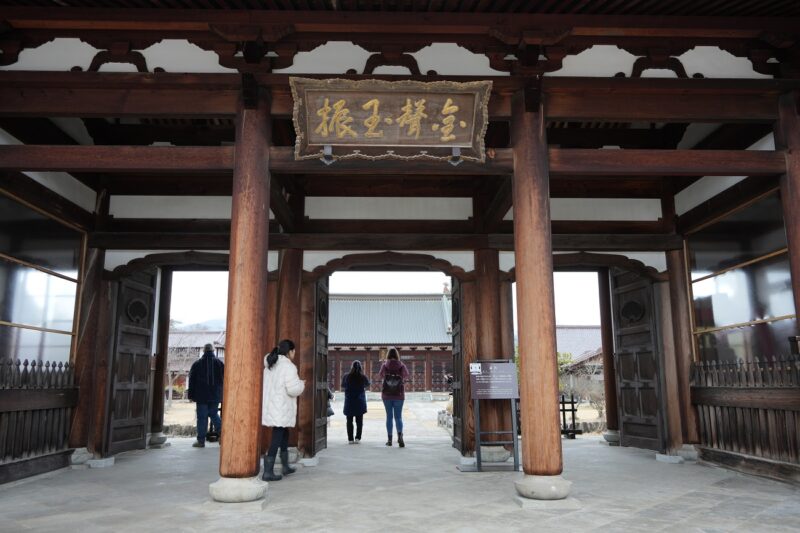
At the heart of Fukushima’s warrior legacy lies Aizu Wakamatsu, a city renowned for its resilient samurai heritage which is on display each year in September during the spectacular three-day Aizu Festival. The presence of the samurai can still be felt throughout Fukushima, especially at the samurai school Nisshinkan. Founded in the early 1800’s, Nisshinkan was one of the most prominent samurai schools in the country, setting the Aizu Clan apart from other samurai in Japan at the during the Edo period.
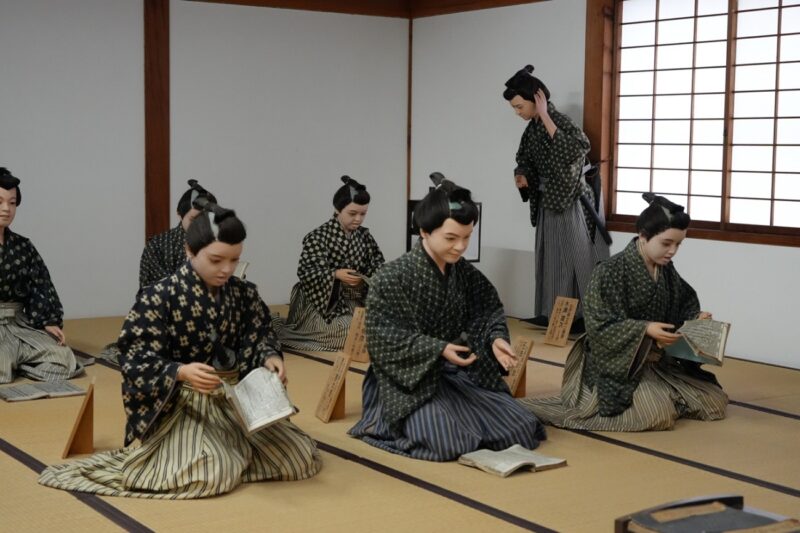
Exploring the scenic school grounds and well-equipped classrooms reveals that samurai were much more than the stiff, brave warriors that are often depicted in media. In addition to martial arts and battle tactics, students also were taught a wide-ranging curriculum that covered a variety of subjects such as mathematics, astronomy, meditation, literature, and art. This institution ingrained both physical and mental discipline into the youth, creating a foundation for how samurai should act from a young age. In fact, signs reminding residents of these codes of conduct, or Ju no Okite can still be found throughout the area and are taught in local schools, just as children learned at Nisshinkan (with one exception).
Obey your elders.
Bow to your elders.
Do not lie.
Do not behave in a cowardly manner.
Do not bully those weaker than yourself.
Do not eat on the street.
Do not interact women outside the home. (outdated)
Above all: Do not do what should not be done.
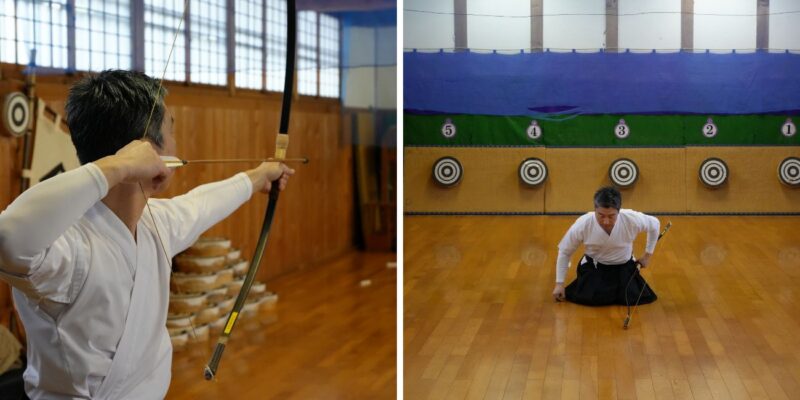
After learning about the samurai’s studies and way of life, I tried learning some warrior skills at the archery range under the guidance of a kind and patient instructor. Besides just practicing hitting the target with accuracy, the exercise teaches about respect and reinforces the samurai mindset.
History and Beauty at Tsurugajo Castle
At Tsurugajo Castle, visitors can explore even more of the region’s samurai heritage at one of Japan’s most unique castles. Though the stronghold was destroyed after the Boshin War, Tsurugajo Castle was rebuilt, memorializing the loyal samurai of Aizu. The white walls and red roof tiles create a striking image enhanced by the beautiful seasonal foliage. In spring around 1,000 cherry blossoms grace the castle grounds with gentle pastel hues, vibrant greens appear in summer, warm fall colors take over in autumn, and winter illuminations scatter dazzling lights across the freshly fallen snow. Besides its visual appeal, the powerful landmark serves as a museum where visitors can learn about Aizu’s dramatic history and Tsurugajo Castle’s days as one of the last samurai strongholds during the Boshin War.
Tsutsumi Productions Forges Ahead
Even after feudal system in Japan came to an end, echoes of clashing samurai swords still reverberated throughout the region. Swordsmiths had to adapt to a new government which outlawed the possession and production of weapons. However, instead of throwing away generations of experience, workshops such as Tsustumi Production took their skills and — like hot iron heated in the undying flames of the samurai spirit — forged them to meet the needs of the time. As the swordsmith business was dwindling, Tsutsumi Production shifted focus and developed a revolutionary stainless steel farming hoe by drawing upon their knowledge of crafting and wielding swords efficiently.
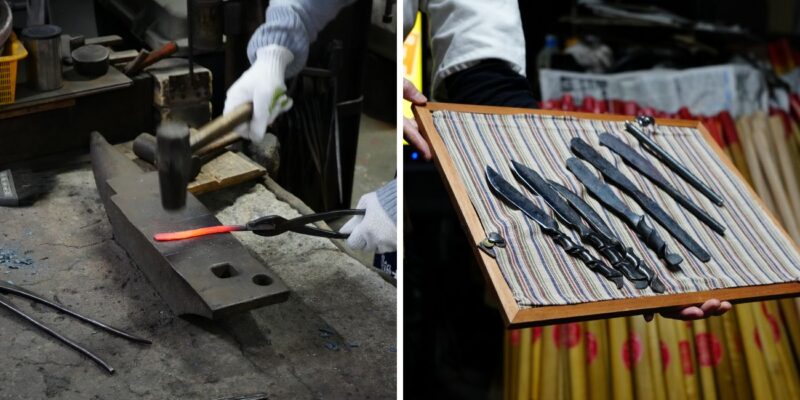
Today, Tsutsumi Productions offers the unique opportunity to delve into the craftsmanship and history of Aizu’s ancestors by taking up the hammer for yourself. For this hands-on experience, Tsutsumi Productions warmly shares their captivating heritage and explains the process of crafting your very own letter-opener. After the program, Tsutsumi Productions adds a final touch and wraps it in locally-crafted cotton pouch. The letter-opener makes a remarkable souvenir that is sure to last.
Modern Entertainment and the Art of the Samurai
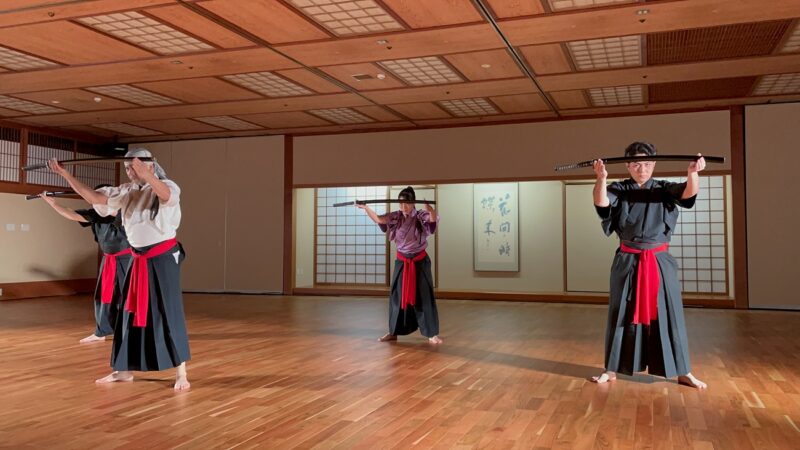
While many hold on to the traditions of the famed scholarly Japanese warriors, Samurai Artist Kamui embraces a more familiar, modern image of samurai that that appears in pop culture around the world. Led by Shimaguchi Tetsuro who appeared in the film “KILL BILL Vol. 1” and choreographed fight scenes, the group puts on a spectacular show that merges the beauty of form with the excitement of acting and martial arts.
Their samurai method, KENGIDO, is described as more than just a martial art. It is a way of communication and spirituality than anyone can practice. Kamui has performed in about 130 cites across over 30 countries, spreading their unique style of martial arts and.
I had the opportunity to talk with Shimaguchi Tetsuro at his dojo in Ookawaso, a luxurious Japanese hot spring resort hotel in Aizu. During our conversation, he expressed the importance of the samurai rules of conduct — a cornerstone of Aizu culture that we learned during our visit to Nisshinkan. Though conceived in ancient times, these rules of conduct are still relevant in daily life. With that in mind, Mr. Shimaguchi encouraged us all to become samurai. Luckily, I soon got my chance and took part in a thrilling choreographed sword battle alongside skilled performers.
Aizu Ashinomaki Hot Spring Resort Hotel Ookawaso
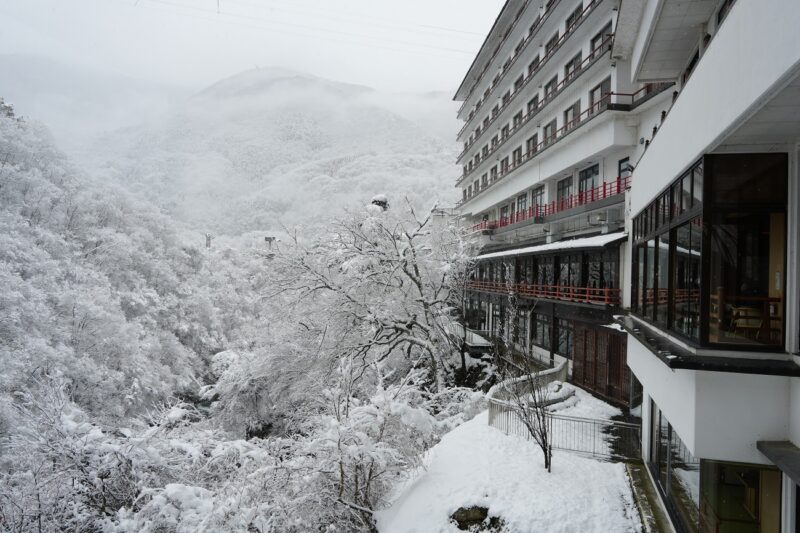
After talking with Mr. Shimaguchi, I had ample time to reflect on my experience while soaking in the soothing waters of Ookawaso’s spacious hot spring baths. Perched above the flowing river, the open-air bath provided breathtaking views of the Ookawa Valley. Covered in a fresh layer of snow, the dreamlike winter landscape spectacularly displayed the enchanting beauty of the season. In autumn, the valley bursts into fiery hues while the verdant mountains rejuvenate the spirit during spring and summer.
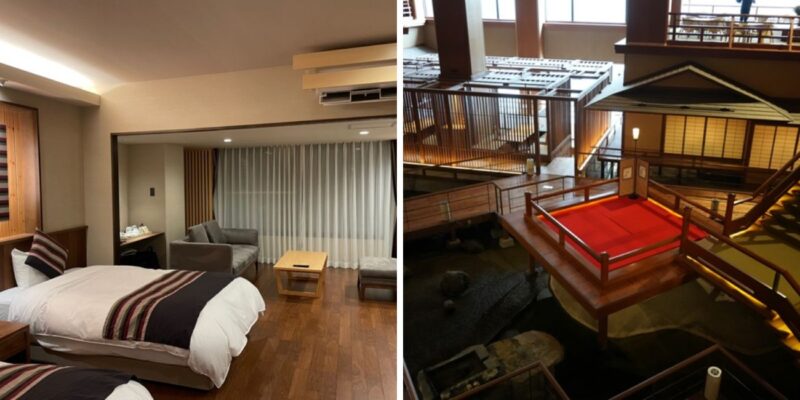
The large Japanese windows in the comfortable modern rooms frame the stunning vistas allowing guests to immerse themselves in the natural splendor. Nightly shamisen performances fill the air with melodies, adding an authentic touch of Japanese tradition to the resorts cozy yet luxurious atmosphere. The resort also offers a sensational dining experience featuring local Aizu cuisine. Conveniently located just 30 minutes away from Aizu Wakamatsu Station, Ookawaso makes an ideal base to explore Fukushima Prefecture’s many extraordinary destinations in any season.
Preserving Aizu Local Heritage
Besides the enduring samurai spirit, there are other ways the people of Aizu keep traditions alive in an ever-changing world. From intricate tea ceremonies that honor centuries-old rituals to vibrant festivals that celebrate history, Aizu holds a deep commitment to preserving its traditional culture. Families pass down culinary traditions, while artisans meticulously craft various dolls, candles, and lacquerware using techniques handed down through centuries.
A Casual Tea Ceremony in a Garden where Feudal Lords Strolled
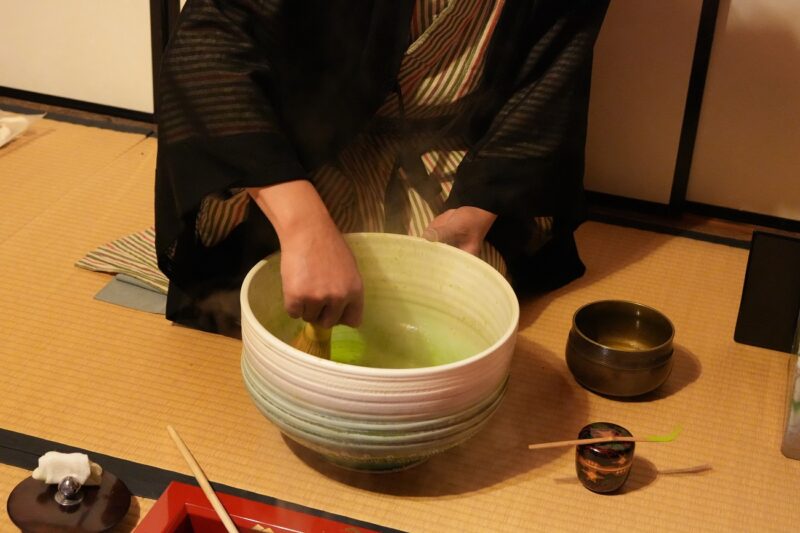
Oyakuen Garden is a traditional Japanese landscape garden where visitors can bask in the tranquility of Fukushima’s natural beauty. The garden was once a place to cultivate medicinal herbs, and hundreds of these types of plants are still grown here today. There are also a few buildings often visited by the feudal lords of Aizu, including a traditional teahouse.
I had the opportunity to join a Japanese tea ceremony hosted by the Aizu Chagakukai while relishing the enchanting view from the teahouse as a flurry gently blanketed the garden in a shimmering powder snow. Along with the refreshing tea and warm hospitality, I could also appreciate the lovely Aizu crafts like lacquerware and other utensils used in the ceremony. Different from typical solemn tea ceremonies, Aizu Chagakukai brings levity as they shared the joy of Aizu’s unique tea culture in a more casual setting. This entertaining experience is recommended especially for first timers.
Life Under the Thatched Roofs of Ouchi-Juku Village
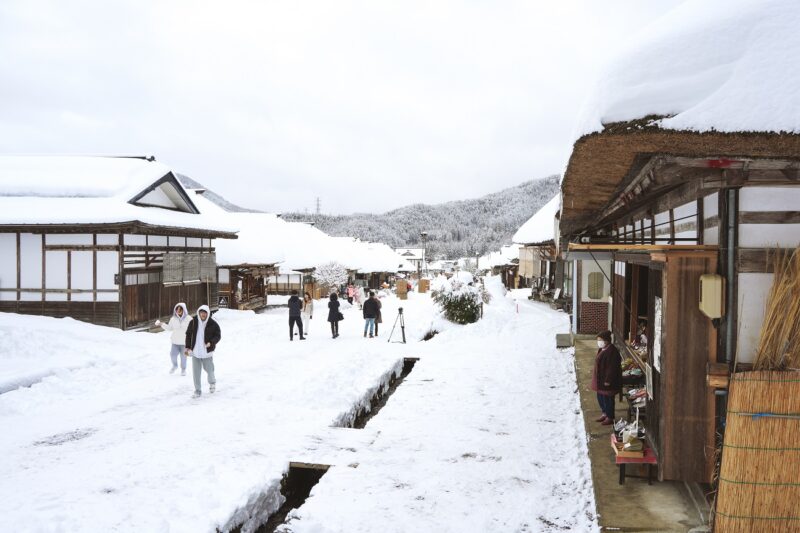
Built around 1640, Ouchi-Juku Village thrived as a post town where travelers could rest on their journey along the historic Aizu-Nishi Kaido route that connected Aizu Wakamatsu and Nikko. The streets of this isolated village in the southwestern mountains of Fukushima are lined with traditional thatched-roof houses that have been lovingly preserved by passionate locals. Despite the great effort and cost to maintain the village as it appeared centuries years ago, members of the Ouchi-Juku Preservation Society (known as the Kayade) recognize the invaluable importance of this village. I had the opportunity to witness their dedication first-hand as I was led through their training facility where the next generation is taught how to construct these magnificent roofs in the traditional manner.
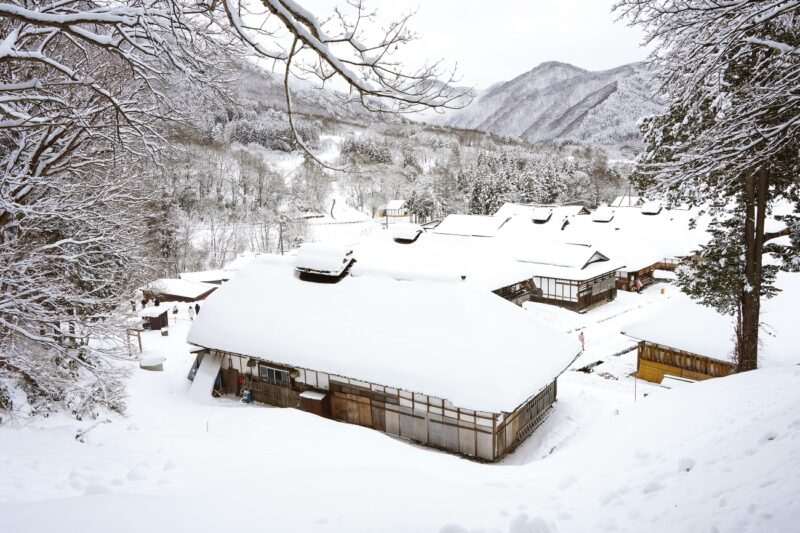
Overlooking the charming village from the mountainside, it’s clear that hard work of the Kayade is well-worth the effort. The captivating scene is like a gorgeous Japanese woodblock print come to life, especially after fresh snowfall. I visited just as the village was preparing for the Snow Festival which is held every February. Despite the winter landscape, the warmth of friendly locals livened up the atmosphere.

A local specialty of Ouchi-Juku is negi soba, which even impressed the feudal lord who declared “this soba represents the height of delicacy.” This traditional buckwheat noodle dish is eaten with a leek instead of with chopsticks to add extra flavor. The experience of slurping up these delicious noodles with such an unusual utensil is just as memorable as its outstanding taste. Misawaya serves this delightful dish in one of Ouchi-Juku’s traditional style buildings, fulling immersing guests in the local culture.
Local Food & Drinks: Gifts of Fukushima’s Rich Nature
As Aizu continues to evolve through the years, one constant is the bountiful nature that has blessed the region with important resources. The region’s distinct seasons, characterized by snowy winters, vibrant springs, lush summers, and colorful autumns, provide an abundant array of ingredients year-round from the succulent fruits like peaches and vegetables nurtured by the fertile soil.
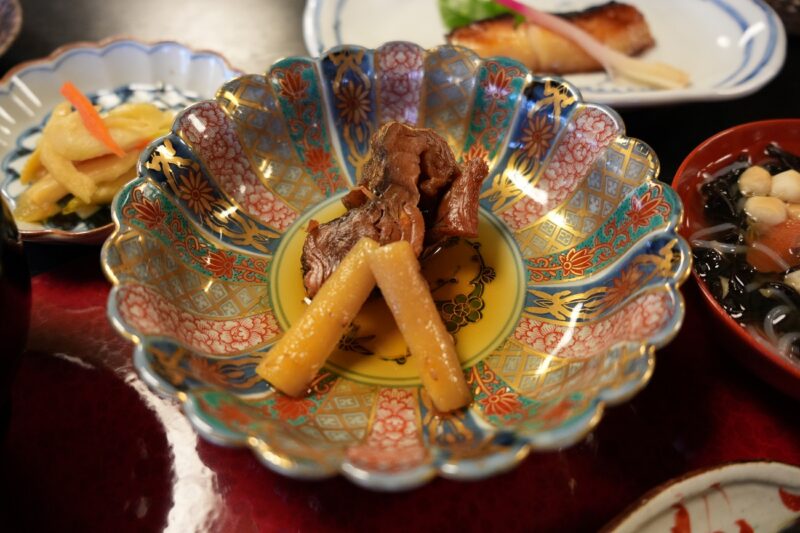
While Aizu may seem distant from the coast, it proudly showcases delectable dishes sourced from the sea. The Shibukawa Merchant House where traders often sold marine products eventually transformed into a restaurant that specialized in dried seafood. Retaining its traditional charm, Shibukawa Tonya serves as a testament to Aizu’s rich heritage, offering a tantalizing array of dishes crafted from locally sourced ingredients.
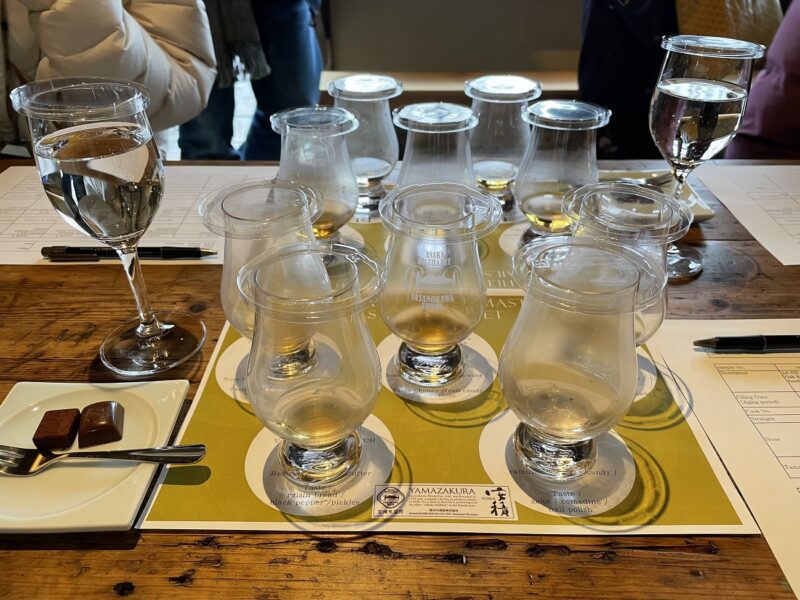
Aizu’s annual heavy snowfall significantly influences its food culture by replenishing crystalline mountain streams and natural springs as it melts. This pure water not only contributes to the cultivation of delicious rice, renowned for producing excellent sake, but also provides ideal conditions for crafting exceptional whiskey. Leveraging Aizu’s climate, shaped by the chilling winds from Mt. Bandai, the Asaka Distillery stands as a distinguished local whiskey producer in the Tohoku region. The original establishment was known for its famous sake, however whiskey production gained popularity after there was a rice shortage. Harnessing knowledge in both whiskey and Japanese sake production, the distillery capitalizes on Aizu’s unique environment to craft a distinctive product. I joined a tour of Asaka Distillery and had the opportunity to try making my own blend of whiskey after a tasting.
Why You Should Visit Aizu in Fukushima Prefecture
Amidst the rugged, breathtaking landscapes of Fukushima Prefecture, Aizu beckons to discerning travelers seeking a luxurious, authentic Japanese experience steeped in the rich history of the region. Aizu’s tranquil vistas, adorned with majestic mountains and lush valleys, offer a serene escape from the hustle and bustle of modern life. For those with a penchant for luxury, Aizu presents a myriad of upscale accommodations with soothing natural hot springs, where traditional Japanese hospitality seamlessly merges with contemporary comforts. Immerse yourself in the region’s storied past as you explore charming villages frozen in time and delve into Aizu’s rich cultural heritage through immersive samurai experiences, traditional tea ceremonies, and vibrant festivals that celebrate the essence of Japanese history and tradition.
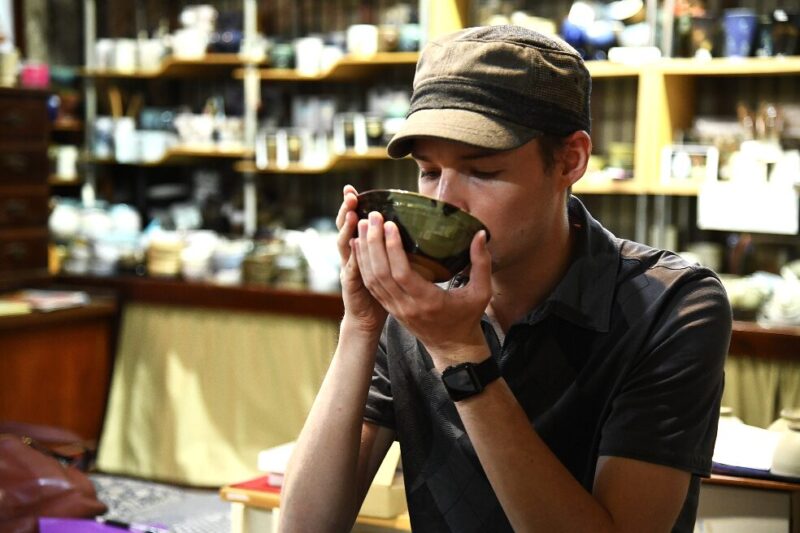
Writer: Andrew Smith
Andrew Smith is an American writer who has lived in Japan for over a decade. He specializes in unearthing Japan’s overlooked charms in lesser-explored regions, guiding readers off the beaten path to discover the marvels authentic Japan on a journey through the country’s rich culture, history, and natural wonders.
 0
0









